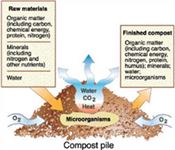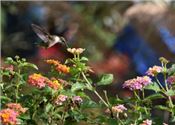Garden Page
'Leaf' It To Nature For Compost And Nutrients

LINDA GEIST
COLUMBIA, MISSOURI
Some gardeners take a hands-off approach to leaves. But leaves left on lawns can pack down into a tight mat, preventing sunlight from reaching the grass, says University of Missouri Extension horticulturist David Trinklein. Leaves also trap and hold moisture, which increases the potential for disease.
However, tree leaves can be a valuable asset to gardeners who want to start a compost pile or add nutrients to lawns, Trinklein says.
First, clear the lawn by mowing damp leaves. Adjust your mower to its highest setting and mow in a crisscross pattern. Mow twice to cut leaves to confetti-size pieces. These small pieces will filter into the lawn, decompose and release nutrients for the grass.
Another option is composting. Compost is created when soil-inhabiting microbes break down plant tissue. When added to soil, compost binds small clay particles together into larger particles. This improves soil aeration, root penetration and water flow in clay-type soils like those found in much of Missouri.
Soil microbes need ample carbon and nitrogen to form compost. Most leaves are high in carbon but low in nitrogen. Adding nitrogen to the compost pile can speed up the decomposition process. This can be accomplished with a general-purpose fertilizer such as 12-12-12 at a rate of about 2 pounds per bushel of leaves, or by adding 1-2 inches of animal manure or green plant material such as grass clippings.
Construct the compost pile in layers, starting with about 4-6 inches of well-shredded leaves followed by a layer of the nitrogen source.
Repeat until the pile is 36-48 inches deep and covers an area of about 25 square feet.
If you want to enclose the compost pile, you can buy specialized composting bins, but wire mesh, concrete block or treated lumber enclosures also work well, Trinklein says.
Water each layer as you add fertilizer. “A properly constructed compost pile should feel damp to the touch, but not wet,” he says.
If using manure as a nitrogen source, make certain of its history.
Some herbicides used in pastures and hayfields pass through the digestive systems of animals and remain in the manure in amounts large enough to damage sensitive species like tomato.
Trinklein says carbon and nitrogen make soil microbes “go bananas,” and their activity will heat up the compost pile. When composting is done correctly, the temperature at the center of the pile should reach about 135-140 F, enough to kill weed seeds, most pathogens and insects.
Decomposition wanes as the microbes run out of food. The compost pile begins to settle and cool, indicating the pile is ready to be turned.
Use a rake or shovel to move partially decomposed leaves from the outer edges of the pile to the center. This renews microbial activity, so the pile will heat up again. Decomposition is complete when the pile fails to heat after being turned.
Leaves may not decompose completely before cold weather sets in, but the process begins again when air temperatures rise in the spring.
Some leaves may be used as mulch for tender plants such as azaleas and rhododendrons. Trinklein says stiff leaves such as those from oak trees do not mat and work best for mulch. Put leaves in a wire cylinder around the plant to keep them in place.
The MU Extension publication “Making and Using Compost” is available for free download at extension.missouri.edu/g6956. ∆
LINDA GEIST: University of Missouri
Select Plants To Attract Migrant Hummingbirds

Lantana produces clusters of small, individual flowers that hummingbirds absolutely love.
Photo by MSU Extension/Gary Bachman
DR. GARY R. BACHMAN
MISSISSIPPI STATE, MISSISSIPPI
It is officially spring, so we can start to get serious about our gardens and landscapes. But this is also the time we enjoy the annual, northward migration of hummingbirds.
That means we need to start thinking about plants that will attract hummingbirds to our landscapes.
Every spring, I get asked what kinds of plants a person should grow to attract these visitors to the garden. Flower shape is important, and by far, plants with tubular flowers are most important. Tubular flowers have the characteristic of being able to hold quite a bit of nectar.
This is part of Mother Nature’s grand plan. Nectar is simply sugar water produced by the plant, and it can be thought of as an energy drink for hummingbirds. As hummingbirds use their bills to probe for nectar, they pick up pollen and transfer it to the next flower visited.
Here are some of my favorite plants with tubular flowers that attract hummingbirds to my landscape. These will also work for your Mississippi gardens.
Lantana produces clusters of small, individual flowers that hummingbirds absolutely love. It is available in a wide variety of color combinations that will look great in your landscape.
Salvia is also a hummingbird magnet, and it has the distinction of being one of my garden landscape must-haves. Both the annual and perennial salvia selections have a wide range of tubular flowers that hummingbirds love.
The big flower heads of pentas have the power to draw hummingbirds to your yard. Clusters of small, individual, five-petal flowers cover these plants all summer long.
Probably my all-time favorite – but really, aren’t they all my favorites? – has to be Vermillionaire cuphea. This Mississippi Medallion winner produces abundant, fiery-hot yellow, red and orange tubular flowers all over the entire plant, making a mound of blooms all summer long. Hummingbird love them.
There are times when the landscape is not producing many flowers and it’s beneficial to have hummingbird feeders hanging in the garden.
There are many types and styles of feeders from which to choose. The feeder selection is up to the individual gardener, but there is only one kind of food for hummingbirds.
You can buy premixed food, but it’s really easy to make your own. All you need to do is mix four parts of water with one part of white sugar. Bring it to a boil and allow to cool before filling your feeders.
Some people think using honey or brown sugar would be a healthier choice, but these sugar sources can be harmful to the hummingbirds. Be sure to change the sugar solution every two or three days to avoid any bacterial growth that can occur in the feeders.
I love watching hummingbirds work a group of flowers as they seemingly float up and down, back and forth as they feed. Consider planting some plants specifically to attract these little garden visitors and enjoy them with me. ∆
DR. GARY R. BACHMAN: Extension/Research Professor, MSU Extension